Christians in Africa
That Christians in Africa, in imitation of the Merciful Jesus, may give prophetic witness to reconciliation, justice, and peace.
For more information, visit the Apostleship of Prayer.
That Christians in Africa, in imitation of the Merciful Jesus, may give prophetic witness to reconciliation, justice, and peace.
For more information, visit the Apostleship of Prayer.
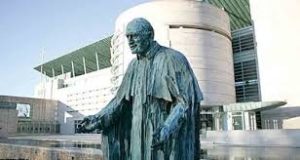 Late in 2016, two sisters from the Congregation of Our Lady of Mercy were sent to the St. John Paul II National Shrine in Washington, DC, to minister to the many pilgrims who come to this sacred place. You will know these sisters as the community which St. Faustina entered in 1925 and received the revelations of God’s Divine Mercy for our times.
Late in 2016, two sisters from the Congregation of Our Lady of Mercy were sent to the St. John Paul II National Shrine in Washington, DC, to minister to the many pilgrims who come to this sacred place. You will know these sisters as the community which St. Faustina entered in 1925 and received the revelations of God’s Divine Mercy for our times.
The Knights of Columbus announced the establishment of a shrine dedicated to Pope John Paul II in 2011. It has proven to be a popular pilgrimage spot for visitors to the capital, especially K of C groups and participants in the annual March for Life. The Knights first met the sisters in Krakow at the Divine Mercy Shrine. They have worked together during World Youth Day, on the film “The Face of Mercy” and other projects.
Each day at the shrine at 3:00pm, the sisters lead the prayer for the Hour of Mercy. One a month, they host “Evenings with the Merciful Jesus” for young people. Other events and scheduled exhibits are held throughout the year.
A first-class relic of St. John Paul II’s blood is contained in a glass ampoule at the center of a reliquary in the Luminous Mysteries Chapel, for veneration by pilgrims. This relic was given as a gift to Supreme Knight Carl A. Anderson by His Eminence Stanisław Cardinal Dziwisz, Archbishop of Kraków and personal secretary to John Paul II.
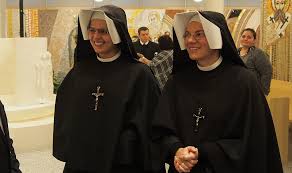 “We understand our presence in the shrine as a continuation of St. John Paul II’s mission to spread the message of Divine Mercy,” said Sister Gaudia, “the message about God whose love is greater than we can imagine.”
“We understand our presence in the shrine as a continuation of St. John Paul II’s mission to spread the message of Divine Mercy,” said Sister Gaudia, “the message about God whose love is greater than we can imagine.”
It is wonderful that many people are introduced here for the first time to the Divine Mercy message. “St. John Paul II called the message of mercy the message of hope for our times,” said Sister Donata. “We believe that this shrine, which attracts more and more people from faraway places, is a special place where people find new hope, which has the power to change their lives.”
To read the whole article in Columbia magazine, click here!
In West Springfield, Massachusetts, on a busy street, up on a hill, is the Dominican Monastery of the Mother of God. Their presence there silently proclaims to the passers-by their faith 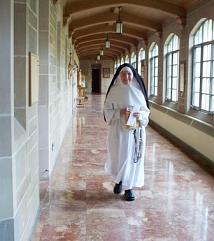 in God and their desire to belong wholly to Him. Their foundress, Mother Mary Hyacinth of Jesus, entered the Dominican Sisters of the Perpetual Rosary in Union City, NJ, on September 8, 1908. She was chosen by Bishop Thomas Mary O’Leary to be the foundress of their community: “Come, come to Springfield in the name of God and Mary. This will be our gift to Our Lady on the feast of her birth.”
in God and their desire to belong wholly to Him. Their foundress, Mother Mary Hyacinth of Jesus, entered the Dominican Sisters of the Perpetual Rosary in Union City, NJ, on September 8, 1908. She was chosen by Bishop Thomas Mary O’Leary to be the foundress of their community: “Come, come to Springfield in the name of God and Mary. This will be our gift to Our Lady on the feast of her birth.”
They eventually took on perpetual adoration of the Blessed Sacrament and went from Third Order sisters to Second Order nuns. Life in modern times is more complicated for everybody, cloistered nuns not excluded, but they have striven in recent times to strengthen the essentials of their enclosed life, striving for the one thing necessary – union with God.
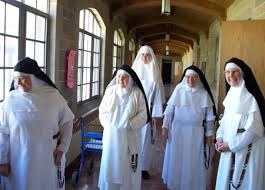 In 2008, reflecting more deeply upon their contemplative vocation after the nuns’ Jubilee Year, they decided to take back their traditional veil, believing that each nun should strive to become a mini “house of prayer.” This was followed by the restoration of a simple grille in their parlors in 2011, as another reminder of their call to silence and withdrawal from the world.
In 2008, reflecting more deeply upon their contemplative vocation after the nuns’ Jubilee Year, they decided to take back their traditional veil, believing that each nun should strive to become a mini “house of prayer.” This was followed by the restoration of a simple grille in their parlors in 2011, as another reminder of their call to silence and withdrawal from the world.
Following the Rule of St. Augustine, they make solemn vows and follow Papal enclosure. The solemn chanting of the Divine Liturgy is at the heart of their day. Their Eucharistic adoration and Rosaries flow out of this wellspring of grace, while study and lectio divina are a fruitful preparation for it. They strive to make the Liturgy as beautiful as they can, all for the glory of God.
May Our Lady, who helped them to begin this work of love for God, allow it flourish through her special Motherly intercession. Amen!
 That young people may respond generously to their vocations and seriously consider offering themselves to God in the priesthood or consecrated life.
That young people may respond generously to their vocations and seriously consider offering themselves to God in the priesthood or consecrated life.
For more information, please visit the Apostleship of Prayer.
For more information, visit the Apostleship of Prayer.
A few years ago, I had the blessing to visit the Carmelite monastery in Terre Haute, Indiana. Since that time, their community has really blossomed with young vocations! There are twelve solemnly professed sisters, one who has professed temporary vows and 3 novices. They also have 2 sisters living with them from China who are learning skills for forming young sisters. All this adds to a vibrant community!
If you would like to learn more about their life as Daughters of St. Teresa of Avila, there is an opportunity coming up. The nuns are hosting a discernment retreat weekend on May 26-28, 2017, at their monastery. During the weekend, you will have the opportunity to learn about the Carmelite way of life and participate in their monastic schedule, inside the enclosure of the monastery. You will also join the nuns for Mass, recreation and meals. What a privilege!
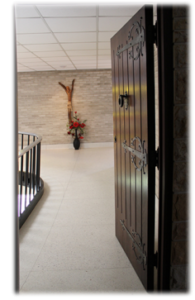
The monastery can trace their roots back to the foundation of the United States and almost back to St. Teresa herself! Here is a brief summary of their history:
The journey in Terre Haute began on the Feast of the Holy Rosary on October 7, 1947. The bishop wanted a second Carmel in his diocese to be a presence of prayer in an area where there were few Catholics. The Indianapolis Carmel, who responded this this request, traced its own roots back to the Bettendorf and Baltimore Carmels, to the original foundation made at Port Tobacco in 1790. This Monastery was the first house of Catholic religious women founded in the original thirteen colonies of the United States of America. The nuns who founded Port Tobacco, in turn, came from Hoogstraet Carmel in the Lowlands. Hoogstraet Carmel was under the direct influence of Blessed Anne of St. Bartholomew, St. Teresa’s trusted companion and nurse, who had spread the Holy Mother’s vision of Carmel into countries and cultures far beyond its birthplace in Spain.
For more information about the discernment weekend, please contact Sr. Clare Joseph, OCD, at vocations@heartsawake.org or visit www.heartsawake.org.
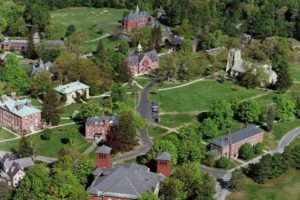 Thomas Aquinas College (TAC) in Santa Paula, California, will soon have an East Coast campus. They have entered into a preliminary grant agreement with the National Christian Foundation (NCF) to accept its gift of a former secondary school campus in Northfield, Massachusetts.
Thomas Aquinas College (TAC) in Santa Paula, California, will soon have an East Coast campus. They have entered into a preliminary grant agreement with the National Christian Foundation (NCF) to accept its gift of a former secondary school campus in Northfield, Massachusetts.
A portion of the 217-acres, located 90 miles northwest of Boston, will be given to Thomas Aquinas College. The campus is comprised of 40 main buildings including dormitories, academic and administration buildings, a library, science hall, auditorium, music building, gymnasium and a chapel. The facility, previously home to Northfield Mount Hermon School, was founded in the 19th century as a preparatory high school by noted evangelist and bible scholar Dwight L. Moody. On part of the property, the Moody Center will continue to preserve his legacy. And, “has the opportunity to again re-establish the property as a preeminent location for teaching and training biblical scholars,” said Emmitt Mitchell of NCF.
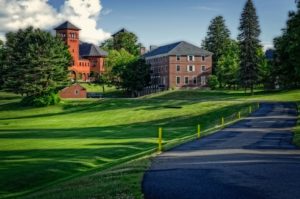 Dr. Michael McLean, President of TAC said: “We have been considering, therefore, the possibility of a second campus. Given the tremendous challenges and costs involved, the question would have remained no more than academic—but for this extraordinary opportunity that the National Christian Foundation has offered us. Never did we imagine we could acquire a campus so fully developed and so beautiful.”
Dr. Michael McLean, President of TAC said: “We have been considering, therefore, the possibility of a second campus. Given the tremendous challenges and costs involved, the question would have remained no more than academic—but for this extraordinary opportunity that the National Christian Foundation has offered us. Never did we imagine we could acquire a campus so fully developed and so beautiful.”
TAC is at full enrollment so this new opportunity gives more students access to their outstanding curriculum while maintaining an intimate community of learners. When fully realized, the campus will be able to support an enrollment of 350- 400 students.
Most Rev. Mitchell T. Rozanski, Bishop of the Diocese of Springfield plans to do whatever he can to help Thomas Aquinas form “faithful witnesses to Christ in our Catholic faith.” Dr. McLean was greatly encouraged by this pledge of assistance and said: “We look forward to working with him to provide even more young people the intellectual, moral, and spiritual formation they need to serve the Church and our country well.”
At Thomas Aquinas College, students acquire a broad and fully integrated liberal education. The College offers one, four-year, classical curriculum that spans the major arts and sciences. Instead of reading textbooks, students read the original works of the greatest thinkers in Western civilization — the Great Books — in all the major disciplines: mathematics, natural science, literature, philosophy, and theology.
 Holy Resurrection Monastery is sui juris (self-governing) monastic community of monks located in Saint Nazianz, Wisconsin. Founded in 1995, they are under the Romanian Catholic Eparchy of St George’s in Canton, Ohio. They are committed to the revival of traditional Eastern Christian monastic life, following the liturgical and fasting regulations of the Byzantine tradition.
Holy Resurrection Monastery is sui juris (self-governing) monastic community of monks located in Saint Nazianz, Wisconsin. Founded in 1995, they are under the Romanian Catholic Eparchy of St George’s in Canton, Ohio. They are committed to the revival of traditional Eastern Christian monastic life, following the liturgical and fasting regulations of the Byzantine tradition.
There are four monks in solemn vows, four novice monks, and one postulant. They also have serious discerners in contact with them. “With the rampant secularism in our society, it is a difficult time for monastic life,” says Abbot Nicholas Zachariadis. “However, given the small size of the Eastern Catholic Churches and the newness of more traditional monastic foundations, I believe, by God’s mercy, Holy Resurrection Monastery is doing quite well!”
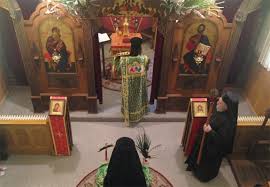 People in the Roman Catholic Church, numbering about 1 billion members, often do not realize that about 20 million Catholics belong to the 21 Eastern Catholic Churches. The monks believe that the Eastern Churches have a lot to contribute to the New Evangelization. “The New Evangelization must offer many things – including sound catechesis, moral guidance, social action, and reverent worship. All of these things, however, must be put into their proper context. They are ultimately not ends in themselves, but aspects of the path to union with God.”
People in the Roman Catholic Church, numbering about 1 billion members, often do not realize that about 20 million Catholics belong to the 21 Eastern Catholic Churches. The monks believe that the Eastern Churches have a lot to contribute to the New Evangelization. “The New Evangelization must offer many things – including sound catechesis, moral guidance, social action, and reverent worship. All of these things, however, must be put into their proper context. They are ultimately not ends in themselves, but aspects of the path to union with God.”
The monks in Saint Nazianz:
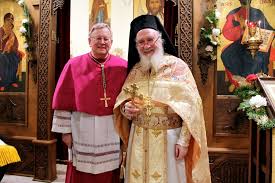 “The closeness of the transcendent God is not a theoretical abstraction. It is a fact – the most important fact there is. The divine presence must become the basis of the believer’s whole life, through that harmony of liturgical and contemplative prayer which is the foundation of Christian mysticism.” (Click here to read the whole article)
“The closeness of the transcendent God is not a theoretical abstraction. It is a fact – the most important fact there is. The divine presence must become the basis of the believer’s whole life, through that harmony of liturgical and contemplative prayer which is the foundation of Christian mysticism.” (Click here to read the whole article)
During this Lent, a generous benefactor has offered the monastery a matching fund grant of up to $50,000. Which means that every $1 donation will be matched up to $50,000. If you would like to support this growing monastery, please visit their website.
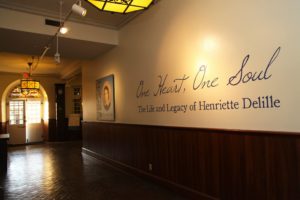 The canonization cause for Ven. Henriette Delille (d. 1862), foundress of the Sisters of the Holy family in New Orleans, continues to move forward. Twenty-nine years ago, her cause was opened and in 2010, Pope Benedict declared her Venerable. As the Sisters celebrate their 175th anniversary this year, they are hoping that the details of a miracle, attributed to Henriette’s intercession, will be accepted and authenticated so that Henriette can be Beatified during this eventful year.
The canonization cause for Ven. Henriette Delille (d. 1862), foundress of the Sisters of the Holy family in New Orleans, continues to move forward. Twenty-nine years ago, her cause was opened and in 2010, Pope Benedict declared her Venerable. As the Sisters celebrate their 175th anniversary this year, they are hoping that the details of a miracle, attributed to Henriette’s intercession, will be accepted and authenticated so that Henriette can be Beatified during this eventful year.
The Sisters of the Holy Family were founded in 1842. The sick, the infirm and the poor were the Sisters’ first concern and the “dearest objects of solicitude,” but they also sought “to bring back the Glory of God and the salvation of the neighbor by a charitable and edifying behavior.” Henriette’s antidote to the dissolution and irreligion of the time was to “teach the mysteries of the religion and the most important points of Christian morality.” One of her priorities was to promote the Sacrament of Marriage. How we need Henriette’s powerful intercession today when families are so under attack!
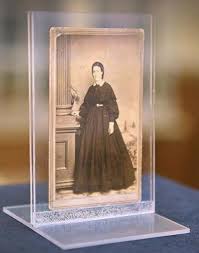 An exhibit on her life at the Ursuline Convent Museum in New Orleans opened late last year and runs through September 2017. Created by the Archdiocese’s archivist, it highlights the life of Henriette, born to a French father (it is believed) and mother who was a “free woman of color” of French, Spanish and African ancestry. Her great, great grandmother, Marie Ann, was a slave who purchased her freedom. The women in Henriette’s family were free, independent and well-to-do. But Henriette broke with family tradition, choosing instead to devote her life to the Lord as a “humble servant of slaves.”
An exhibit on her life at the Ursuline Convent Museum in New Orleans opened late last year and runs through September 2017. Created by the Archdiocese’s archivist, it highlights the life of Henriette, born to a French father (it is believed) and mother who was a “free woman of color” of French, Spanish and African ancestry. Her great, great grandmother, Marie Ann, was a slave who purchased her freedom. The women in Henriette’s family were free, independent and well-to-do. But Henriette broke with family tradition, choosing instead to devote her life to the Lord as a “humble servant of slaves.”
A documentary on her life is available and for more information on her community and her Cause, please visit the Sister’s website.
Comfort for the Afflicted
That all those who are afflicted, especially the poor, refugees, and marginalized, may find welcome and comfort in our communities.
For more information, please visit the Apostleship of Prayer.